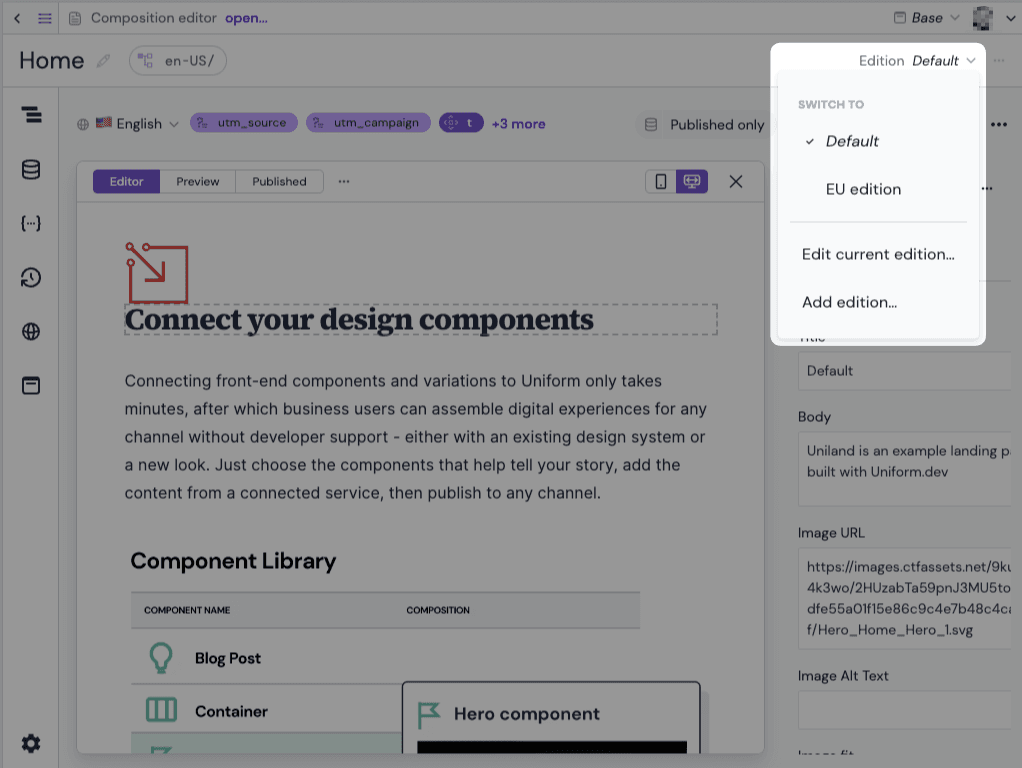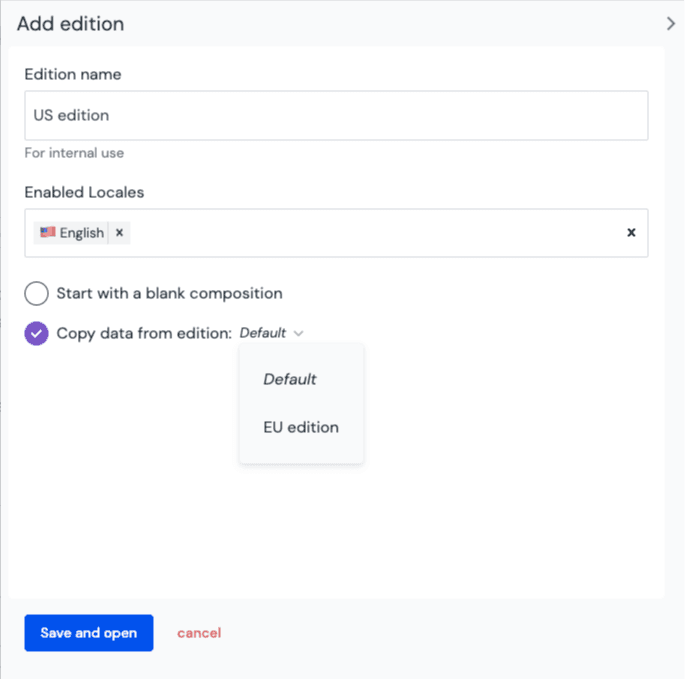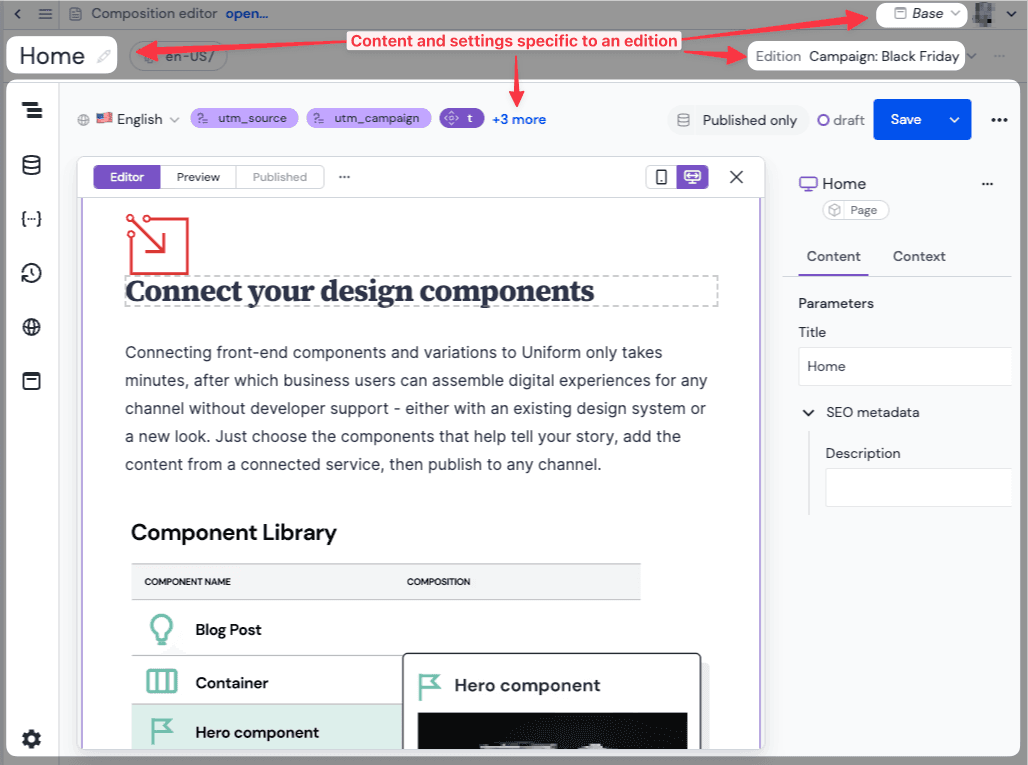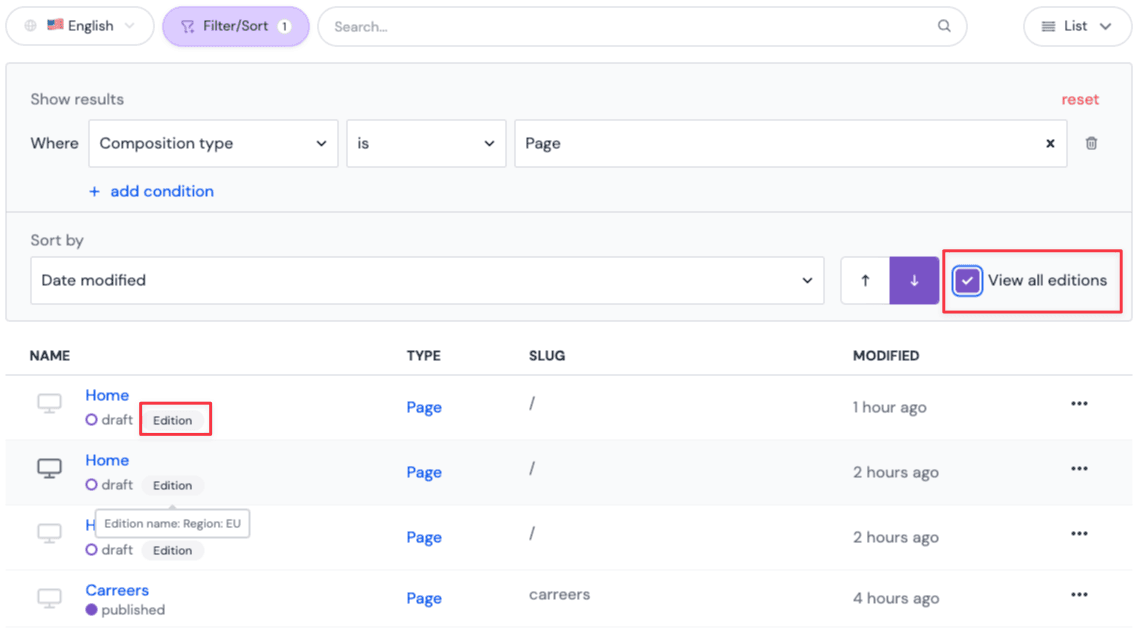Editions
Enterprise plan only
The Editions feature requires a Uniform Enterprise plan. Please contact your Uniform representative to provision your project with this feature.
Editions is a powerful feature that allows for the creation and management of multiple versions of a composition or entry. This feature is designed to address the complex needs of global, multi-market content strategies and adapting to seasonal or campaign-specific content requirements.
What are editions?#
Editions are independent versions of a composition or content entry, each with its own content and publishing lifecycle. Derived from the original composition or entry (the "default edition"), they have unique component structures, content, data resources, and locales. Editions are automatically resolved based on the current locale.
Key characteristics of editions#
Independent content lifecycle: Each edition has its own content and publishing lifecycle. This means it can be saved, edited, published, and scheduled with releases independently. Each edition has its own content history. If the underlying composition type or content type has attached workflows, then each edition follows an individual workflow process.
Unique content and structure: Each edition has its own content and content structure, allowing flexibility to adapt content to different business or market requirements.
Flexible locale management: Each edition has one or more locales enabled. When fetching a composition or entry for a specific locale, the appropriate edition is returned that has the locale enabled.
Attached to a composition or entry: Editions are always attached to a composition or entry and cannot exist independently. Editions share the same ID as the composition or entry they are attached to and are differentiated by their edition ID.
Patterns don't have editions
Patterns themselves cannot have editions. Since editions are meant to create variations of specific content instances, it wouldn't make sense to apply editions to patterns, which are intended to remain consistent.
However, editions can be based on composition or entry patterns, and component patterns can be used within composition editions to maintain consistency across different versions of your content. By enabling locales in a pattern, you can centrally manage and share the translations for components across different editions.
Use cases#
Market-specific or regional content structures and workflows#
You can enable multiple locales in an edition to represent different markets or regions. As each edition can have its own content structure and workflow, you can adapt the content to the specific requirements of each market or region such as regional or seasonal campaigns and promotions or roll out product launches in different markets at different times.
By defining different editions for each market, you can ensure that local teams have full autonomy over their content and publishing process for their region while being able to consume shared content and components from patterns.
Campaigns or seasonal promotions#
With editions you can create temporary versions of a composition or entry to support campaigns or seasonal promotions. Once the campaign or promotion is over, you can lower the priority, unpublish or delete the campaign edition and the original composition or entry is restored.
Global or cross-market campaigns#
You can even enable different combinations of locales to launch campaigns that span multiple markets or regions. For example you have a edition for each country that only has the country-specific locales enabled. But for a global campaign, you can create a new edition with all locales enabled to temporarily override the content for all countries by giving the global campaign edition a higher priority. Once you unpublish or delete the global campaign edition, the original editions for each country are in effect again.
Manage editions#
Editions are accessible from the Editions menu in the right-hand side of the header in the composition or entry editor.

Using the Editions menu you can manage the following actions:
- Switch between editions by choosing the edition in the list to edit the content of that edition.
- Add a new edition
- Edit the settings of the current edition
Add an edition#
Add a new edition for the current composition or entry by choosing Add edition... option in the editions menu:
- Give the edition a meaningful name that makes sense in the context of the current composition or entry.
- Choose which locales to enable for the edition.
- Choose how the new edition should be created:
- Start with a blank composition/entry: This creates a new edition with a blank composition or entry. No existing content is copied to the new edition.
- Copy data from edition: This creates a new edition and copies the content, components and data from the edition that you choose in the dropdown. Only the values of then selected locales are copied when they also exist in the source edition.
- Confirm the edition creation by clicking the Save and open button.
- A new editions is created and basic composition and entry metadata like name and slug is copied from the original edition. Which content is copied depends on the selection in the previous step. Once the new edition is ready it is opened in the visual editor.

Edit the settings of an edition#
Edit the current edition settings by choosing Edit current edition... option: this allows you to change the name and the priority of the edition.
Also it gives you an overview of which locales are enabled across all editions.
Set priority of an edition#
The priority of an edition is used to determine which edition should be used when there are multiple editions with the same locale enabled.
- Switch to the editions you want to manage the priority for.
- Select the Edit current edition option in the editions menu.
- Enter the priority for the edition in the Priority field. The ordering will update automatically and reflect how the new priority value is ranking among the other editions.

Delete an edition#
An edition can be deleted by choosing the Delete button in the editions listing. This will delete the edition and all its content and components.

Edit content in editions#
Each edition is fully independent from a content and workflow perspective. This means that you can edit the content in an edition without affecting the content in other editions like you would do when editing a standalone composition or entry.
Each edition has its own:
- set of enabled locales
- values for its parameters or fields
- component structure of child components in its slots (compositions only)
- data resources
- workflow status
- publishing status
- publishing history
- assignment to releases
- composition name and slug

Remember to save and publish editions
Don't forget that each edition needs to be saved and published independently. After making changes to an edition, ensure you save your work and publish the edition for the changes to take effect.
Search and filter editions#
When applying search and filters in composition or entry listings, only the edition that is resolved against the current selected locale is shown. If no locale is specified, the default edition is used.
You can use search and filters to match across editions by enabling the View all editions toggle in the filter settings.

Resolve editions#
The following rules are applied to resolve the edition:
- When fetching a composition or entry, the edition is returned based on the requested locale.
- If the the requested locale is enabled in multiple editions, the edition with the highest priority is returned. If the editions have the same priority, then alphabetical order of the edition name is used to resolve the edition.
- If the requested locale is not enabled in any published edition then a
Not found - 404error is returned. - If no locale is specified, the default edition is returned. The default edition is the original version of the composition or entry that was created when the composition or entry was first created.
Best Practices#
Only use editions when necessary#
Editions are an advanced feature to support complex business requirements but add complexity to the content management process.
Since editions are fully independent versions of a composition or entry they create additional management, maintenance, and governance needs. Editions can result in undesirable extra work for authors when they are overused. We recommend you do not add editions until there is a clear business need - they can always be added later.
For less complex use cases, consider applying conditional logic to adapt content to different markets without creating independent editions.
Typically any of the following scenarios indicate that you should consider using editions:
- You have completely different components or content for different markets or regions.
- You have independent editorial teams for different markets or regions.
- For different markets or regions you need the ability to independently change and publish content. For example, a new product or campaign needs to launch in different markets at different times.
- You need to manage temporary content variations for campaigns or promotions that need to be rolled back after the campaign ends.
Use patterns to avoid duplication#
Limit editions to only contain content that is unique to that edition.
Make use of composition patterns and component patterns to share common components and translations across multiple editions.
Define slot sections in patterns to define where regional or campaign-specific content can be added in editions.
As patterns can also be published and scheduled independently, they can be used to roll out changes across multiple editions with a single action.
Define editions based on editorial and business requirements#
When creating editions, consider the distinct content and workflow requirements for each edition and how your team is structured to manage these. It is not always necessary to create a new edition for each market or region. If you are translating and publishing the same content across multiple languages and markets, it might be more efficient to use a shared edition with all required locales enabled.
For example, you can have a shared edition for all Scandinavian countries managed by a single team. This allows the team to share the same content and publishing lifecycle across their region while maintaining different locales and translations for each country.
The naming and organization of editions do not impact your frontend applications and are not visible to end users. Therefore, you can define editions based on your editorial team's structure and content management practices.
Establish a clear naming convention#
Give editions a clear and meaningful name that follows a naming convention. This helps content editors understand the purpose of the edition that they are editing and to have consistent naming across all compositions and entries that have multiple editions. Edition names are internal only and not exposed to the end users of the front-end applications.
Example naming conventions:
- By market or regions:
Region: EU,Region: APAC,Country: US - By campaign or promotions:
Campaign: Easter,Campaign: Summer,Campaign: Black Friday - By editorial teams:
Team: Nordic,Team: APAC